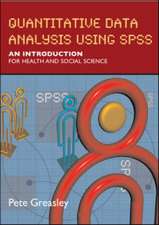Social Network Analysis: History, Theory and Methodology
Autor Christina Prellen Limba Engleză Paperback – 25 oct 2011
This engaging book represents these interdependencies' positive and negative consequences, their multiple effects and the ways in which a local occurrence in one part of the world can directly affect the rest. Then it demonstrates precisely how these interactions and relationships form.
This is a book for the social network novice learning how to study, think about and analyse social networks; the intermediate user, not yet familiar with some of the newer developments in the field; and the teacher looking for a range of exercises, as well as an up-to-date historical account of the field.
It is divided into three clear sections:
1. historical & Background Concepts
2. Levels of Analysis
3. Advances, Extensions and Conclusions
The book provides a full overview of the field - historical origins, common theoretical perspectives and frameworks; traditional and current analytical procedures and fundamental mathematical equations needed to get a foothold in the field.
| Toate formatele și edițiile | Preț | Express |
|---|---|---|
| Paperback (1) | 433.70 lei 6-8 săpt. | |
| SAGE Publications – 25 oct 2011 | 433.70 lei 6-8 săpt. | |
| Hardback (1) | 1087.47 lei 6-8 săpt. | |
| SAGE Publications – 25 oct 2011 | 1087.47 lei 6-8 săpt. |
Preț: 433.70 lei
Preț vechi: 510.24 lei
-15% Nou
82.100€ • 86.33$ • 68.52£
Carte tipărită la comandă
Livrare economică 14-28 aprilie
Specificații
ISBN-10: 1412947154
Pagini: 272
Dimensiuni: 170 x 242 x 20 mm
Greutate: 0.48 kg
Ediția:1
Editura: SAGE Publications
Colecția Sage Publications Ltd
Locul publicării:London, United Kingdom
Recenzii
"I would heartily recommend this book to anyone interested in getting acquainted with SNA. Its pragmatic point of view--with recurring hints on how to perform different kinds of analysis using UCINET, a popular software tool for SNA--makes this book especially suitable for practitioners."
This book by Christina Prell more than adequately fulfils a promise to meet the needs of those coming to the field for the first time, the intermediate researcher looking to develop skills in the field and for teachers seeking a comprehensive account that will help inform their students.[...] It offers a straightforwardly clear and practical ‘how to’ together with introductions to the favoured computer software applications – always a valuable insight to the neophyte. Indeed if I were to seek a ‘foothold’ in SNA this is where I would start.
Cuprins
Introduction: What Are Social Networks?
PART ONE: BACKGROUND UNDERSTANDING
Becoming Familiar with Social Networks
A Brief History of Social Network Analysis
How to Study Social Networks, from Theory to Design
PART TWO: LEVELS OF ANALYSIS
Actor Level in Complete Networks
Actor Level in Ego Networks
Dyad and Triad Levels
Subgroups Level
Network Level
Position and Roles Analysis
PART THREE: Advances, Extensions and Conclusions
Statistical Models for Social Networks
Conclusions and Future of the Field
Appendices
Appendix 1: Getting Started with UCINET
Appendix 2: Exponential Random Graph Modelling and Longitudinal Modelling through Siena
Appendix 3: Calculating Probability for Transitivity Using Actor-Based Models
Descriere
We live in a world that is paradoxically both small and vast; each of us is embedded in local communities and yet we are only a few 'links' away from anyone else in the world.
This engaging book represents these interdependencies' positive and negative consequences, their multiple effects and the ways in which a local occurrence in one part of the world can directly affect the rest. Then it demonstrates precisely how these interactions and relationships form.
This is a book for the social network novice learning how to study, think about and analyse social networks; the intermediate user, not yet familiar with some of the newer developments in the field; and the teacher looking for a range of exercises, as well as an up-to-date historical account of the field.
It is divided into three clear sections:
1. historical & Background Concepts
2. Levels of Analysis
3. Advances, Extensions and Conclusions
The book provides a full overview of the field - historical origins, common theoretical perspectives and frameworks; traditional and current analytical procedures and fundamental mathematical equations needed to get a foothold in the field.



















